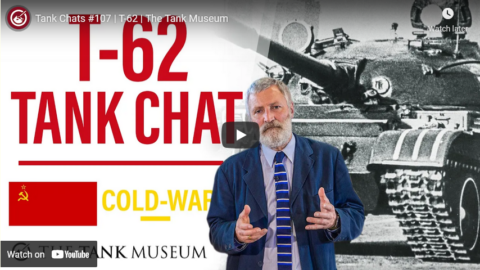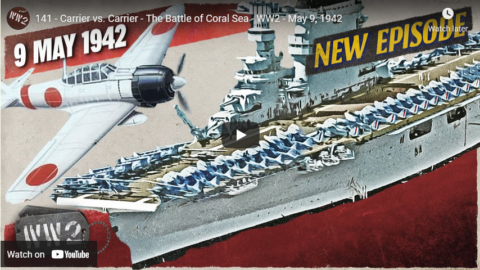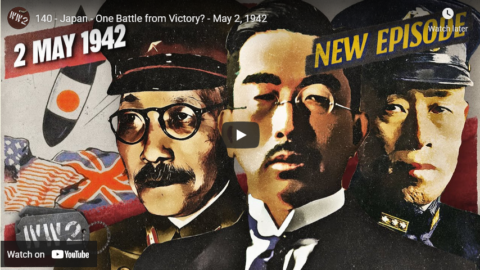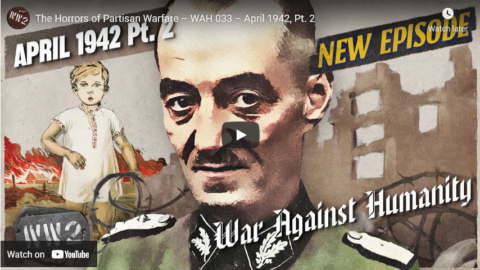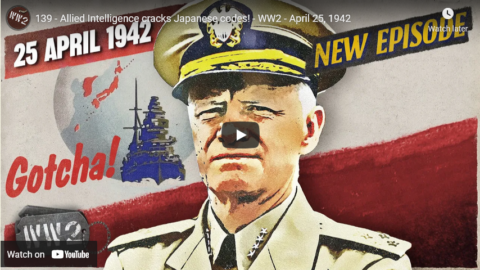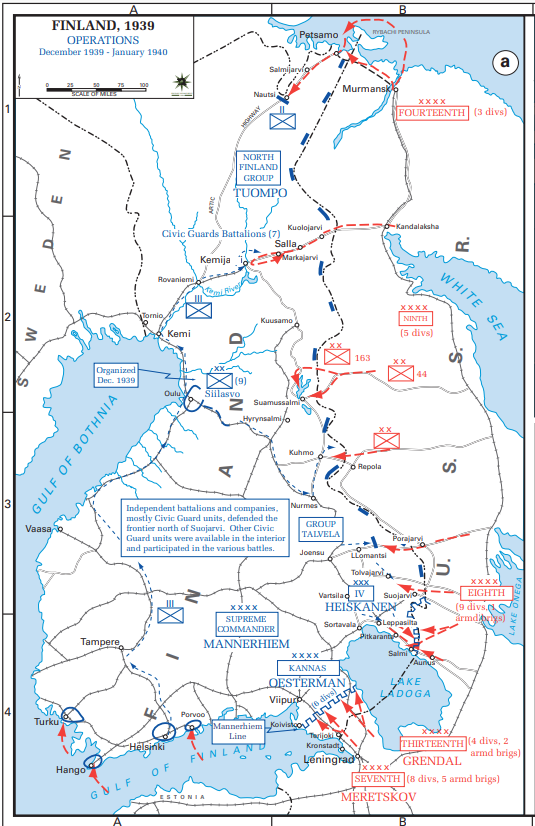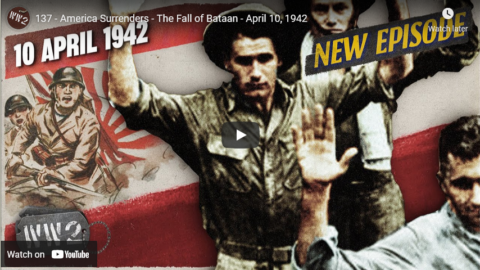The Tank Museum
Published 9 Oct 2020Here The Tank Museum’s Curator David Willey discusses the Soviet T-62, including its development and service life. Introduced in 1962, it was a further evolution of the T-55 series, which David discussed in Tank Chat #104.
Support the work of The Tank Museum on Patreon: ► https://www.patreon.com/tankmuseum
Visit The Tank Museum SHOP & become a Friend: ► tankmuseumshop.orgTwitter: ► https://twitter.com/TankMuseum
Instagram: ► https://www.instagram.com/tankmuseum/
#tankmuseum #tanks
May 21, 2021
Tank Chats #107 | T-62 | The Tank Museum
May 18, 2021
What is Maskirovka? Russian Military Deception #Military101
Military History Visualized
Published 5 May 2017A short introduction into Russian Military Deception — called Maskirovka. “Maskirovka is most simply defined as a set of processes designed to mislead, confuse, and interfere with accurate data collection regarding all areas of Soviet plans, objectives, and strengths or weaknesses.” (Smith, Charles L.: “Soviet Maskirovka“, in: Airpower Journal – Spring 1988)
Military History Visualized provides a series of short narrative and visual presentations like documentaries based on academic literature or sometimes primary sources. Videos are intended as introduction to military history, but also contain a lot of details for history buffs. Since the aim is to keep the episodes short and comprehensive some details are often cut.
» HOW YOU CAN SUPPORT MILITARY HISTORY VISUALIZED «
(A) You can support my channel on Patreon: https://www.patreon.com/join/mhv(B) You can also buy “Spoils of War” (merchandise) in the online shop: https://www.redbubble.com/people/mhvi…
» SOCIAL MEDIA LINKS «
twitter: https://twitter.com/MilHiVisualized
tumblr: http://militaryhistoryvisualized.tumb…» SOURCES «
Maier, Morgan: A Little Masquerade: Russia’s Evolving Employment of Maskirovka
http://cgsc.contentdm.oclc.org/cdm/si…Smith, Charles L.: “Soviet Maskirovko“, in: Airpower Journal – Spring 1988
http://www.airpower.maxwell.af.mil/ai…Lindley-French, Julian: NATO: Countering Strategic Maskirovka. Canadian Defence & Foreign Affairs Institute. (2015)
Glantz: The Red Mask: The Nature and Legacy of Soviet Military Deception in the Second World War
https://en.wikipedia.org/wiki/Russian…
Keating, Kenneth: The Soviet System of Camouflage
http://www.dtic.mil/dtic/tr/fulltext/…Krueger, Daniel: Maskirovka – What’s in it for us?
http://www.dtic.mil/dtic/tr/fulltext/…» TOOL CHAIN «
PowerPoint 2016, Word, Excel, Tile Mill, QGIS, Processing 3, Adobe Illustrator, Adobe Premiere, Adobe Audition, Adobe Photoshop, Adobe After Effects, Adobe Animate.» CREDITS & SPECIAL THX «
Song: Ethan Meixsell – “Demilitarized Zone”
May 16, 2021
Joseph Stalin Jumps the Gun – 142 – May 16, 1942
World War Two
Published 15 May 2021The Soviets pre-empt a German offensive with one of their own in the south of the Eastern Front, but that’s not the only fighting. The skies over Malta and the waters of the Gulf of St. Lawrence are full of action. Meanwhile, two races against time — and the Japanese — come to an end in India.
(more…)
May 9, 2021
Carrier vs. Carrier – The Battle of the Coral Sea – WW2 – 141 – May 9, 1942
World War Two
Published 8 May 2021This week sees a major clash between the naval forces of the Japanese and the Allies. Both sides take big damage, though on the tactical level it is a victory for the Japanese. Operationally, however, they must postpone their attacks towards Port Moresby. They are busy making plans all the while, though, for their upcoming attack against Midway Atoll in the Central Pacific. They also finally have success ending an offensive this week with the conquest of the Philippines when Corregidor falls. Japan’s ally Germany begins an offensive of their own this week on the Kerch Peninsula. The Allies, for their part, launch an offensive of their own this week against Vichy French-held Madagascar, and they take the main port, Diego Suarez.
Join us on Patreon: https://www.patreon.com/TimeGhostHistory
Or join The TimeGhost Army directly at: https://timeghost.tvGet Collectibles here: https://timeghost.tv/collectibles/
Follow WW2 day by day on Instagram @ww2_day_by_day – https://www.instagram.com/ww2_day_by_day
Between 2 Wars: https://www.youtube.com/playlist?list…
Source list: http://bit.ly/WW2sourcesWritten and Hosted by: Indy Neidell
Director: Astrid Deinhard
Producers: Astrid Deinhard and Spartacus Olsson
Executive Producers: Astrid Deinhard, Indy Neidell, Spartacus Olsson, Bodo Rittenauer
Creative Producer: Maria Kyhle
Post-Production Director: Wieke Kapteijns
Research by: Indy Neidell
Edited by: Iryna Dulka
Sound design: Marek Kamiński
Map animations: Eastory (https://www.youtube.com/c/eastory)Colorizations by:
– Daniel Weiss
– Mikołaj Uchman
– Norman Stewart – https://oldtimesincolor.blogspot.com/
– Dememorabilia – https://www.instagram.com/dememorabilia/Sources:
– IWM A 9471
– Narodowe Muzeum CyfroweSoundtracks from the Epidemic Sound:
– Rannar Sillard – “Easy Target”
– Jo Wandrini – “Dragon King”
– Jo Wandrini – “To War!”
– Fabien Tell – “Last Point of Safe Return”
– Brightarm Orchestra – “On the Edge of Change”
– Reynard Seidel – “Rush of Blood”
– Craft Case – “Secret Cargo”
– Gunnar Johnsen – “Not Safe Yet”
– Edward Karl Hanson – “Spellbound”
– Johan Hynynen – “One More Thought”
– Rannar Sillard – “March Of The Brave 4”
– Johan Hynynen – “Dark Beginning”
– Phoenix Tail – “At the Front”Archive by Screenocean/Reuters https://www.screenocean.com.
A TimeGhost chronological documentary produced by OnLion Entertainment GmbH.
May 2, 2021
Japan – One Battle from Victory? – 140 – May 2, 1942
World War Two
Published 1 May 2021Now Burma and control of the Burma Road have fallen to the Japanese. Can nothing stop them? The Allies are thinking about maybe using the Solomon Islands as a base to build to try and fight back, but to do that they’ll need control of the Coral Sea, but both sides are sending warships there since the Japanese plan to take Port Moresby. The Allies are aware of this, however, since they have the advantage of being able to read a substantial part of Japan’s radio traffic. It is a week of foreshadowing not just there, but also as the Allies send ships to take Madagascar from the Vichy French and the Soviets prepare to launch an offensive in the south of the Eastern Front.
Join us on Patreon: https://www.patreon.com/TimeGhostHistory
Or join The TimeGhost Army directly at: https://timeghost.tvFollow WW2 day by day on Instagram @ww2_day_by_day – https://www.instagram.com/ww2_day_by_day
Between 2 Wars: https://www.youtube.com/playlist?list…
Source list: http://bit.ly/WW2sourcesWritten and Hosted by: Indy Neidell
Director: Astrid Deinhard
Producers: Astrid Deinhard and Spartacus Olsson
Executive Producers: Astrid Deinhard, Indy Neidell, Spartacus Olsson, Bodo Rittenauer
Creative Producer: Maria Kyhle
Post-Production Director: Wieke Kapteijns
Research by: Indy Neidell
Edited by: Iryna Dulka
Sound design: Marek Kamiński
Map animations: Eastory (https://www.youtube.com/c/eastory)Colorizations by:
– Daniel Weiss
– Norman Stewart – https://oldtimesincolor.blogspot.com/Sources:
– IWM JAR 1240, A 9483Soundtracks from the Epidemic Sound:
– Rannar Sillard – “Easy Target”
– Jo Wandrini – “Dragon King”
– Fabien Tell – “Other Sides of Glory”
– Brightarm Orchestra – “On the Edge of Change”
– Edward Karl Hanson – “Spellbound”
– Johan Hynynen – “Dark Beginning”
– Rannar Sillard – “Split Decision”
– Dream Cave – “The Beast”Archive by Screenocean/Reuters https://www.screenocean.com.
A TimeGhost chronological documentary produced by OnLion Entertainment GmbH.
April 30, 2021
The Horrors of Partisan Warfare – WAH 033 – April 1942, Pt. 2
World War Two
Published 29 Apr 2021April 1942 sees bombing campaigns in Germany and Britain, as well as German anti-partisan actions in the Balkans and Eastern Europe.
Join us on Patreon: https://www.patreon.com/TimeGhostHistory
Or join The TimeGhost Army directly at: https://timeghost.tvFollow WW2 day by day on Instagram @ww2_day_by_day – https://www.instagram.com/ww2_day_by_day
Between 2 Wars: https://www.youtube.com/playlist?list…
Source list: http://bit.ly/WW2sourcesHosted by: Spartacus Olsson
Written by: Spartacus Olsson and Joram Appel
Director: Astrid Deinhard
Producers: Astrid Deinhard and Spartacus Olsson
Executive Producers: Astrid Deinhard, Indy Neidell, Spartacus Olsson, Bodo Rittenauer
Creative Producer: Maria Kyhle
Post-Production Director: Wieke Kapteijns
Research by: Joram Appel
Edited by: Miki Cackowski
Sound design: Marek Kamiński
Map animations: Miki Cackowski and Eastory (https://www.youtube.com/c/eastory)Colorizations by:
Klimbim https://www.flickr.com/photos/2215569…
Mikołaj Uchman
Spartacus Olsson
Daniel WeissSources:
IWM MH 24764, HU 36196, Q(HS) 256, D 16649
Yad Vashem 48AO3, 953, 86FO2, 3116/71
Bundesarchiv
Tito giving a speech in Foča, courtesy of Музеј Старе Херцеговине
Narodowe Archiwum Cyfrowe
Star of David, courtesy of Jacek Proszyk https://commons.wikimedia.org/wiki/Fi…
Picture of Gustav Braun von Stumm, courtesy of Thomas Föhl https://www.geni.com/photo/view/60000…Soundtracks from the Epidemic Sound:
Wendel Scherer – “Defeated”
Johan Hynynen – “Dark Beginning”
Jon Bjork – “Disposal”
Christian Andersen – “Barrel”
Wendel Scherer – “Growing Doubt”
Jon Bjork – “For the Many”
Reynard Seidel – “Deflection”
Gavin Luke – “Drifting Emotions 3”
Jon Bjork – “Icicles”
Gunnar Johnsen – “Not Safe Yet”Archive by Screenocean/Reuters https://www.screenocean.com.
A TimeGhost chronological documentary produced by OnLion Entertainment GmbH.
Update: TimeGhost had to repost a censored version of this episode and provided this explanation:
World War Two
1 hour ago (edited)
The original version of this video was age restricted by YouTube for containing pictures of dead bodies. We do not feel that it is correct to document these events by finessing history and self censoring, but YouTube has left us no choice. We have several problems with these age restrictions, but let’s start off with what an age restriction means on YouTube. In theory it simply restricts the video from anyone who isn’t over 18 and logged in to the YouTube platform, but in effect it does much more than that;1. It takes the video out of most subscribers’ feeds and notification lists
2. In some countries like for instance South Korea, for legal reasons it is not accessible at all, for anyone
3. YouTube ranks it lower in their recommendation engines sending out recommendations to view to only a fraction of the ‘normal’ recommendations
4. It can no longer be viewed off YouTube as an embedded video – meaning that it won’t display even on our own website
5. It gets a boiler plate informing the viewer that the content has been “identified by the community as offensive to some viewers”
6. On many mobile devices it cannot be shared with the YouTube app
7. In countries were legal proof of age is required for adult content you have to provide a driver’s license, or credit card proving you are over 18In effect that means that YouTube is soft censoring the video from a large section of potential viewers. The result is that we get around half, or less of the views on videos that are age restricted. And we should note that according to YouTube’s own system more than 90% of our viewers are over 18, so it’s not just an effect of losing underage viewers.
Now, this content is without any doubt hard to watch, but it’s educational content based on solid facts, documented through crystal clear academic research. It is about the crimes against humanity during WW2. It documents events that are to this day in 2021, denied by sympathizers of extreme ideologies. Because of the special importance for new generations to learn about these events, many countries, especially in the EU and North America, do not require in their youth protection laws or media regulation that this kind of content shall be for 18+ only. To the contrary many countries have these topics, told just as graphically as we document them on their school curriculum for ages 13 and above. Moreover, YouTube has in their own community guidelines a provision that allows for displays of violence, dead bodies, and so on in an educational context also for under 18s.
So in effect YouTube is here choosing to restrict, even censor content of high educational importance although they are not legally required to do so, and they have their own provisions to allow it to be unrestricted. Why do they do that? Well, we can’t read their minds, but we have some indications that;
A) they ere on the side of caution to avoid ANY legal risk.
B) They fear any kind of content that has to do with extremism, even when unmasking it after the advertising boycotts they faced a couple of years back.
C) when the community complains they put extra weight on those complaintsIt is item C that troubles us the most. We have over 500 videos on our channels – very many of them contain graphic images of death and violence for reasons of the topics we document. Among these videos, a few dozen have been age restricted, while the rest have not. The common denominator between the age restricted videos is that they document events, or phenomena that unmask extremism by historical Communists, Nazis, and Imperialists. Its is difficult to not see the common interest by sympathizers of these groups and YouTube. If you want something suppressed, and there’s an easy way to just get it suppressed by just pressing a button – is it not reasonable to assume that you would use that button? We’re not conspiracy mythologists, we don’t believe there is a conspiracy here, but just by creating a simple path to fulfill different, but in effect common interests YouTube has made it easy for deniers of crimes against humanity, and war crimes to suppress information about these events.
We have explained to YouTube that inadvertently they are supporting the exact kind of hateful extremism they are fighting against with their other sword arm. We have implored them to lift the age restrictions in the interest of what society has decided: that content like this needs to be freely accessible in the public space. Despite an otherwise good and healthy relationship to the platform operators who are after all our distribution partners,, we have been met with standard replies, and a denial for our request.
Once again we express our dismay, sadness, and disappointment that YouTube chooses to restrict access to content that should serve a greater good; that we do not forget the victims of atrocities and extremism so that we can learn from our past and improve our societies.
Never Forget.
April 25, 2021
Allied Intelligence cracks Japanese codes! – 139 – WW2 – April 25, 1942
World War Two
Published 24 Apr 2021After last week’s Doolittle Raid on Tokyo, pretty much the entire Japanese fleet is sent out looking for American ships. They do not find them, but the enormous amount of radio traffic they generate is a treasure trove for Allied codebreakers to work on. The Allies ship 46 British Spitfire planes to Malta … and all of them are destroyed by the Axis within 48 hours. Germany begins bombing tourist and cultural destinations in Britain, and to make things even worse for the British this week, they realize they can’t hold Burma and are now making tracks for India, with the Japanese Army in hot pursuit.
Get Collectibles here: https://timeghost.tv/collectibles/
Join us on Patreon: https://www.patreon.com/TimeGhostHistory
Or join The TimeGhost Army directly at: https://timeghost.tvFollow WW2 day by day on Instagram @ww2_day_by_day – https://www.instagram.com/ww2_day_by_day
Between 2 Wars: https://www.youtube.com/playlist?list…
Source list: http://bit.ly/WW2sourcesWritten and Hosted by: Indy Neidell
Director: Astrid Deinhard
Producers: Astrid Deinhard and Spartacus Olsson
Executive Producers: Astrid Deinhard, Indy Neidell, Spartacus Olsson, Bodo Rittenauer
Creative Producer: Maria Kyhle
Post-Production Director: Wieke Kapteijns
Research by: Indy Neidell
Edited by: Iryna Dulka
Sound design: Marek Kamiński
Map animations: Eastory (https://www.youtube.com/c/eastory)Colorizations by:
– Mikołaj Uchman
– Daniel WeissSources:
– National Portrait Gallery
– Naval History and Heritage Command
– Book by Rob Crosswell, Arrow by 4B Icons – from the Noun Project
– Russian International News AgencySoundtracks from the Epidemic Sound:
– Rannar Sillard – “Easy Target”
– Jo Wandrini – “Dragon King”
– Howard Harper-Barnes – “Underlying Truth”
– Edward Karl Hanson – “Spellbound”
– Craft Case – “Secret Cargo”
– Johan Hynynen – “Dark Beginning”
– Andreas Jamsheree – “Guilty Shadows 4”Archive by Screenocean/Reuters https://www.screenocean.com.
A TimeGhost chronological documentary produced by OnLion Entertainment GmbH.
April 24, 2021
This Insane Helicopter Was The Largest Ever Built: The Mil V-12 Story
Mustard
Published 10 Sep 2020Sign up for an annual CuriosityStream subscription and you’ll also get a free Nebula subscription (the new streaming platform built by creators) here: http://CuriosityStream.com/mustard
Research and writing in collaboration with Tomás Campos.
The Soviets built some of the largest and most technically advanced helicopters in the world. By 1957, the Mil Mi-6 had already emerged as the largest helicopter ever built, far out-sizing helicopters built in the west. But for the Soviet Union, the need to build a helicopter far larger than even the Mi-6, soon became a matter of national security.
By 1960, American U-2 spy planes conducting high altitude reconnaissance flights over the Soviet Union were beginning to uncover the location of the country’s Intercontinental Ballistic Missile (ICBM) sites. These first generation R-7 Semyorka ICBMs were being deployed throughout the Soviet Union as fast as possible, but their enormous size and weight meant they could only be delivered to launch sites using trains. The need to build rail lines to launch sites made the ICBM sites easy to spot in U.S. reconnaissance photos.
Keeping the missile sites hidden was a matter of national security. The Soviets devised a bold plan to airlift ICBMs into the vast and remote Soviet wilderness, thereby eliminating the need for rail lines or even roads. This would make it virtually impossible for spy planes to track down missile sites hidden in over twelve million square kilometres of forests. But to make the plan work, the Soviets would need to build a helicopter with at least twice the lifting power of the Mi-6.
Design studies for the new enormous helicopter began in 1959, with the Soviet Council of Ministers formally approving development in 1962. But development of such an ambitious helicopter would progress slowly, as various configurations (single rotor, tandem and transverse) were studied. Construction of testing-rigs, transmission systems and mock-ups began in 1963, and construction of the first prototype started in 1965. The new prototype would be designated as the Mil V-12 (with plans to designate the production version as Mil Mi-12). The first test flight in 1967 ended in failure as the V-12 crashed back to earth sustaining minor damage due to oscillations caused by control problems. A second test flight a year later proved the helicopter’s airworthiness.
The V-12 would go on to break numerous world records for lifting capacity, but its fate had already been sealed by a rapidly changing strategic situation. The introduction of spy satellites, and the development of new lighter and mobile ICBMs made hiding nuclear missiles strategically irrelevant.
In 1970, the Soviet Air Force refused to accept the V-12 into state acceptance trials, due to a lack of need. Although a second V-12 prototype would be constructed in 1972, there were simply too few scenarios that would require such a large and complex helicopter. In 1974 development of the V-12 was cancelled and the Mil Design Bureau shifted efforts to designing the Mil Mi-26, the largest helicopter to enter service.
Select footage courtesy the AP Archive:
AP Archive website: http://www.aparchive.com YouTube: https://www.youtube.com/c/aparchive and https://www.youtube.com/c/britishmovi…Special thanks to Nick Arehart for helping clean up our audio:
https://twitter.com/airhrt_Link to the Mustard Store:
teespring.com/stores/mustard-storeMusic used in this production (reproduced under license):
Intro Song: “Space Cinematic”- https://www.pond5.com/royalty-free-mu…
Song 2: “Yet Another Chase” – https://www.epidemicsound.com/track/X…
Song 3: “The Board Is Set” – https://www.epidemicsound.com/track/g…
Song 4: “Grim March” – https://www.pond5.com/royalty-free-mu…
Song 5: “Like the Wind” – https://www.pond5.com/royalty-free-mu…
Song 6: “Synthwave Industrial Technology” – https://audiojungle.net/item/synthwav…
Thanks for watching!
April 22, 2021
The Winter War
In Quillette, Sean McMeekin outlines the disaster of the first Soviet offensive against Finland in the opening battles of the 1939-40 Winter War:
While Finland, with a tiny population of scarcely 3.5 million, could hardly have threatened the Soviet colossus, it had fought fiercely for independence during the Russian Civil War, conquering Helsinki in April 1918 and dealing the Reds a series of painful blows. The Finnish White Guards — as the Bolsheviks referred to the forces then commanded by the redoubtable Gustaf Mannerheim — had also, Stalin remembered, worked with German troops and collaborated with the British Baltic fleet. Had Mannerheim’s connections with the Germans not been so strong, the British might have lent his Finnish guards more support in the critical days of fall 1919, when Petrograd nearly fell to the Whites. But this was small consolation to Stalin, who mostly remembered the humiliation of losing Finland and Finnish double-dealing with outside powers. The fear that Finland might once again invite in a power hostile to the USSR, whether Britain or Germany, was never far from Stalin’s mind.
When Molotov summoned a Finnish delegation to the Kremlin on October 12th, 1939, Stalin made a personal appearance to heighten the intimidation factor, and he handed the Finns a brutal ultimatum demanding, among other things, “that the frontier between Russia and Finland in the Karelian Isthmus region be moved westward to a point only 20 miles east of Viipuri, and that all existing fortifications on the Karelian Isthmus be destroyed.” Stalin made it clear that this was the price that Finland had to pay to avoid the fate of Poland.
Aggressive and insulting as the Soviet demands on Finland were, Stalin and Molotov fully expected them to be accepted. As the Ukrainian party boss and future general secretary Nikita Khrushchev later recalled, the mood in the Politburo at the time was that “all we had to do was raise our voice a little bit and the Finns would obey. If that didn’t work, we could fire one shot and the Finns would put up their hands and surrender.” Stalin ruled, after all, a heavily armed empire of more than 170 million that had been in a state of near-constant mobilization since early September. The Red Army had already deployed 21,000 modern tanks, while the tiny Finnish Army did not possess an anti-tank gun. The Finnish Air Force had maybe a dozen fighter planes, facing a Red Air armada of 15,000, with 10,362 brand-new warplanes built in 1939 alone. Finnish Army reserves still mostly drilled with wooden rifles dating to the 19th century. By contrast, the Red Army was, in late 1939, the largest in the world, the most mechanized, the most heavily armored, and the most lavishly armed, even if surely not — because of Stalin’s purges — the best led.
[…]
Just past dawn on November 30th, Stalin’s undeclared war against Finland began with a furious artillery barrage on all fronts, followed by the scream of warplanes overhead. The only difference between the bald acts of territorial aggression in Finland and Poland was that the Soviet blitzkrieg was less efficient. Soviet medium bombers — mostly SB-2s cautiously dropping one-ton payloads from heights of 3,000 feet or more — weren’t especially accurate. In Helsinki, Russian bombers failed to knock out a single docking bay, airfield runway, Finnish warplane, or oil tank (although one airport hangar was destroyed). A stray bomb hit the Soviet legation building. According to eyewitnesses, Red fighter pilots strafed Helsinki suburbs as well, “machine-gunning women and children who had fled their houses to the fields.” Similar scenes of horror were repeated in Viipuri (Vyborg), as well as in provincial towns such as Lahti, Enso, and Kotka.
Meretskov’s landward assault on the Karelian Isthmus fared poorly. During the interval between the border incident of November 26th and the Russian onslaught early on November 30th, Mannerheim had wisely evacuated most of the civilian population. A series of clever booby traps were set for the invaders, including “pipe mines” — steel tubes crammed with explosives buried in snowdrifts and set off by hidden trip wires. The most effective defense of all was the Molotov cocktail, first used in Spain but ingeniously updated by the Finns, who would fill liquor bottles with a blend of gasoline or kerosene, tar, and potassium chloride. In fits of derring-do, Finnish soldiers on skis would drop these into the turrets of advancing tanks, ram branches or crowbars into the tank treads, or slice holes in the ice to sink them. Despite boasts in the Russian high command that the campaign would be over in 12 days, by mid-December, most of the Soviet Seventh and Thirteenth Armies were still blundering along short of the Mannerheim Line. On December 17th, in fact, the Thirteenth Army actually went into reverse, retreating after bloody losses in a clash at Taipale. By then, even the tiny Finnish Air Force of old Dutch Fokker fighters had joined the rout, knocking down Soviet bombers — one Finnish ace took out six in four minutes — and doing wonders for the morale of the Finns below. Further north, the Soviet Ninth Army was nearly destroyed in a battle near a burned-out Suomussalmi on December 9th. One Finnish ski sniper, a farmer named Simo Häyhä, personally killed, according to (improbable) legend, more than 500 Russians[*]. Wounded Russians overwhelmed the hospitals of Leningrad. One overworked Soviet surgeon complained in early December that he was dealing with nearly 400 wounded Red Army soldiers every day.
* The story of Simo Häyhä was set to music by Sabaton in their song “White Death” on the Coat of Arms album. Indy Neidell discussed the history behind the music in a Sabaton History video in 2019.
April 21, 2021
Tank Chats #104 | T-54 & T-55 | The Tank Museum
The Tank Museum
Published 14 Aug 2020Here Curator David Willey discusses the T-54, and its successor the T-55, tanks which can source their roots back to the Second World War and are probably the most produced tanks of all time.
Support the work of The Tank Museum on Patreon: ► https://www.patreon.com/tankmuseum
Visit The Tank Museum SHOP & become a Friend: ► tankmuseumshop.orgTwitter: ► https://twitter.com/TankMuseum
Instagram: ► https://www.instagram.com/tankmuseum/
#tankmuseum #tanks
April 18, 2021
America Strikes Back – Tokyo in Flames – WW2 -138 – April 18 1942
World War Two
Published 17 Apr 2021The Doolittle Raid is just a little bombing raid over Tokyo that doesn’t do that much physical damage. It does, however, have big repercussions — partly in terms of future offensive plans for the Japanese fleet, and partly in terms of the thousands of Chinese lives taken in reprisals for allowing the US bombers to land in China. There is small scattered action on the Eastern Front, more Japanese advances in Burma, and a French VIP escapes captivity in Germany and heads for Switzerland and freedom.
Join us on Patreon: https://www.patreon.com/TimeGhostHistory
Or join The TimeGhost Army directly at: https://timeghost.tvFollow WW2 day by day on Instagram @ww2_day_by_day – https://www.instagram.com/ww2_day_by_day
Between 2 Wars: https://www.youtube.com/playlist?list…
Source list: http://bit.ly/WW2sourcesWritten and Hosted by: Indy Neidell
Director: Astrid Deinhard
Producers: Astrid Deinhard and Spartacus Olsson
Executive Producers: Astrid Deinhard, Indy Neidell, Spartacus Olsson, Bodo Rittenauer
Creative Producer: Maria Kyhle
Post-Production Director: Wieke Kapteijns
Research by: Indy Neidell
Edited by: Iryna Dulka
Sound design: Marek Kamiński
Map animations: Eastory (https://www.youtube.com/c/eastory)Colorizations by:
– Mikołaj Uchman
– Norman Stewart – https://oldtimesincolor.blogspot.com/Sources:
– Stan S. Katz
– IWM: IND 3595
– Image of ‘The Fortress of Königstein from the North-West’ by Bernardo Bellotto, © National Gallery of Art, WashingtonSoundtracks from the Epidemic Sound:
– Rannar Sillard – “Easy Target”
– Howard Harper-Barnes – “London”
– Jo Wandrini – “Dragon King”
– Dream Cave – “The Beast”
– Reynard Seidel – “Rush of Blood”
– Wendel Scherer – “Out the Window”
– Brightarm Orchestra – “On the Edge of Change”
– Gunnar Johnsen – “Not Safe Yet”
– Johan Hynynen – “Dark Beginning”
– Philip Ayers – “Trapped in a Maze”Archive by Screenocean/Reuters https://www.screenocean.com.
A TimeGhost chronological documentary produced by OnLion Entertainment GmbH.
April 15, 2021
QotD: The “evil” of profits
The slogan into which the Nazis condensed their economic philosophy, viz., Gemeinnutz geht vor Eigennutz (i.e., the commonweal ranks above private profit), is likewise the idea underlying the American New Deal and the Soviet management of economic affairs. It implies that profit-seeking business harms the vital interests of the immense majority, and that it is the sacred duty of popular government to prevent the emergence of profits by public control of production and distribution.
Ludwig von Mises, Planned Chaos, 1947.
April 14, 2021
War Stories We Didn’t Get to Tell – WW2 – Reading Comments
World War Two
Published 13 Apr 2021Another edition of Across the Airwaves, where Indy, Sparty, and Astrid look at interesting and unique comments from our videos. In this episode, some amazing war stories that we didn’t get to tell.
Join us on Patreon: https://www.patreon.com/TimeGhostHistory
Or join The TimeGhost Army directly at: https://timeghost.tvFollow WW2 day by day on Instagram @ww2_day_by_day – https://www.instagram.com/ww2_day_by_day
Between 2 Wars: https://www.youtube.com/playlist?list…
Source list: http://bit.ly/WW2sourcesHosted by: Indy Neidell, Spartacus Olsson, and Astrid Deinhard
Director: Astrid Deinhard
Producers: Astrid Deinhard and Spartacus Olsson
Executive Producers: Astrid Deinhard, Indy Neidell, Spartacus Olsson, Bodo Rittenauer
Creative Producer: Maria Kyhle
Post-Production Director: Wieke Kapteijns
Edited by: Karolina Dołęga
Sound design: Marek Kamiński
Map animations: Eastory (https://www.youtube.com/c/eastory), Karolina DołęgaSources:
– Bundesarchiv
– Library of Congress
– Australian War Memorial
– Icons from the Noun Project: Boat by Richard Cordero, captain by Gan Khoon Lay, Mine Ship by Luke Anthony Firth, Wrench by Gregor Cresnar
– Explosion animation by Ignisium from YouTube
– Uboat.net, picture of SS Oklahoma courtesy of Texaco ArchivesSoundtracks from Epidemic Sounds:
– “Other Sides of Glory” – Fabien Tell
– “London” – Howard Harper-Barnes
– “Deflection” – Reynard Seidel
– “The Inspector 4” – Johannes Bornlöf
– “What Happens in the Park” – Claude SignetArchive by Screenocean/Reuters https://www.screenocean.com.
A TimeGhost chronological documentary produced by OnLion Entertainment GmbH.
From the comments:
World War Two
2 hours ago (edited)
Day in day out, we review thousands of comments from people across the world. It’s always heartening to come across the ones that are particularly interesting, educational, touching, or even funny. This format, “Across the Airwaves”, is a great way for us to interact directly with our community and in this episode, Indy, Sparty and Astrid mainly look at comments from people offering extra details and analysis that we didn’t have the chance to include in our regular content.Hope you enjoy hearing them. A big thanks to our community, especially our TimeGhost Army members.
April 12, 2021
“War Communism” in the Soviet Union, 1917-1921
J.W. Rich outlines the economic and humanitarian disaster of Soviet “War Communism” that eventually forced Lenin to bring back some limited elements of capitalism to save the country:
In 1917, the Bolsheviks seized power in Moscow after the deposition of the democratic provisional government which had replaced the Tsar. However, the Bolsheviks’ hold on power was far from secure. There was little affection anywhere for the Tsar, but there was no agreement on what form of government should replace the monarchy. Bolshevism had been on the rise for years, but ideas of democracy and liberalism were gaining popularity as well. Shortly after the 1917 revolution, the Russian Civil War broke out between the Reds, the Bolsheviks, and the Whites, a coalition of anti-Bolsheviks that were generally democratic.
Through the course of the civil war, the Bolsheviks gained more power and control over increasingly large amounts of Russia. With this control, they began to implement their Marxist economic ideas into reality. On January 28, 1918, it was decreed that all factories should be directed by state-appointed managers. In effect, this amounted to a near-complete nationalization of industry. In one fell swoop, the vast majority of the production of Russia’s consumer goods was now under the purview and direction of the state.
On May 9, 1918, a grain monopoly was announced over grain production in the country. All grain harvested across the country was now the property of the state. This was extended even further when a general food levy was announced in January 1919. Any and all food was now the property of the state. In addition, local farm authorities were no longer allowed to set the levy based on harvest estimates. In essence, the state would take however much it wanted from the peasants without any concern if they had enough food to feed themselves and their families.
It was at this point that large-scale forced rationing was introduced. Money was made worthless overnight as ration cards were mandated to the entire population. No longer could you buy whatever you wished with the money you had. The goods allocated for you were predetermined on your ration card.
By late 1920, going into 1921, the Russian Civil War was all but over. The Whites had been soundly defeated by the Reds, giving the Bolsheviks control of nearly the entirety of the country. However, despite the victory in the Civil War, the economy at home was beginning to fall apart. Industrial production was at 20% of pre-war levels by 1920. As a result of this lagging production, there were few goods in the cities available. This resulted in a flight from the cities to the countryside. From 1918 to 1920, eight million people emigrated from the cities to the villages, where there was better hope of finding food or some goods. In Moscow and Petrograd, the population declined by 58.2%
The agricultural situation was not much better. Sheldon Richman records that from 1909-1913, gross agricultural output averaged 69 million tons. By 1921, it was just 31 million. From 1909-1913, sown area was over 224 million acres. In 1921, only 158 million acres were sown. This lack of food resulted in a mass loss of population. From 1917 to 1922, the entire population declined by 16 million, not counting immigration and deaths from the civil war.
War Communism was now fully implemented and the Marxist aspirations of Lenin and the Bolsheviks were now fulfilled. For the people that had to live under War Communism, however, the conditions had become intolerable. In February 1921, labor strikes began to emerge all over Russia. With the end of the civil war and living standards continuing to fall, resistance to the Bolsheviks began to spread throughout the country. Moscow was the first city to strike, with other large cities, such as Petrograd, following. The protestors demanded an end to War Communism and a restoration of private enterprise and civil liberties, such as the freedom of speech and assembly.
The protests escalated when the Kronstadt Naval Base mutinied against the government. Once a bastion of Bolshevik support and fervor, the sailors joined with the laborers in demanding reform and change. A force led by Trotsky was dispatched to deal with the mutiny, but Lenin knew that change was needed. The writing was on the wall for War Communism.
April 11, 2021
America Surrenders – The Fall of Bataan – 137 – April 10, 1942
World War Two
Published 10 Apr 2021After holding out since the beginning of the year, the American and Filipino defenders at Bataan can do so no more, and they surrender to the Japanese — the Bataan Death March for the 75,000 prisoners begins. Meanwhile, the Japanese carrier fleet launches a raid on Colombo and shipping in the Bay of Bengal, wrecking Britain’s Eastern Fleet in the process and forcing them to move to African coastal bases. Adolf Hitler issues the directive outlining his plans for a summer offensive against the USSR that aim south toward the Caucasus.
Join us on Patreon: https://www.patreon.com/TimeGhostHistory
Or join The TimeGhost Army directly at: https://timeghost.tvCheck out Indy’s Tie Barn to get your own tie right here: https://www.youtube.com/c/IndysTieBar…
Follow WW2 day by day on Instagram @ww2_day_by_day – https://www.instagram.com/ww2_day_by_day
Between 2 Wars: https://www.youtube.com/playlist?list…
Source list: http://bit.ly/WW2sourcesWritten and Hosted by: Indy Neidell
Director: Astrid Deinhard
Producers: Astrid Deinhard and Spartacus Olsson
Executive Producers: Astrid Deinhard, Indy Neidell, Spartacus Olsson, Bodo Rittenauer
Creative Producer: Maria Kyhle
Post-Production Director: Wieke Kapteijns
Research by: Indy Neidell
Edited by: Iryna Dulka
Sound design: Marek Kamiński
Map animations: Eastory (https://www.youtube.com/c/eastory)Colorizations by:
– Mikołaj Uchman
– Daniel Weiss
– Norman Stewart – https://oldtimesincolor.blogspot.com/Sources:
– IWM A 25477, A 10499Soundtracks from Epidemic Sound:
– Rannar Sillard – Easy Target
– Jo Wandrini – Dragon King
– Farrell Wooten – Duels
– Andreas Jamsheree – Guilty Shadows 4
– Howard Harper-Barnes- Underlying Truth
– Johan Hynynen – Dark Beginning
– Gunnar Johnsen – Not Safe Yet
– Flouw – A Far Cry
– Brightarm Orchestra – On the Edge of ChangeArchive by Screenocean/Reuters https://www.screenocean.com.
A TimeGhost chronological documentary produced by OnLion Entertainment GmbH.

